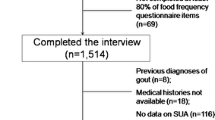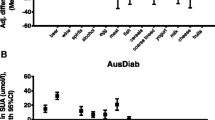Abstract
Objectives
To estimate the prevalence of hyperuricemia and lifestyle risk factors for hyperuricemia in elderly women.
Design
Cross-sectional study.
Setting
The suburban area of Guangzhou, Guangdong province, China.
Participants
The study included 856 Chinese women aged 60 to 102 years who received their annual health examinations in the suburban area of Guangzhou, South China in 2002.
Measurements
Information on anthropometric measurements and lifestyle factors were obtained via a questionnaire processed by the attending physicians or nurses. Blood biochemistry was performed after subjects fasted for 8–14 h. Unconditional logistic regression analysis was used to investigate associations between hyperuricemia, meat intake quintiles, physical activity quintiles, and alcohol intake quintiles.
Results
The prevalence of hyperuricemia in the studied population was 12.01%. Alcohol, meat and seafood consumption; being overweight or obese; hypertension; and abnormal triglyceride levels were strongly associated with a higher prevalence of hyperuricemia. Physical activity was inversely related to the prevalence of hyperuricemia. The odds ratios for hyperuricemia for quintiles of physical activity were 1.00, 0.74, 0.72, 0.63, and 0.55 (P<0.01).
Conclusions
Our data suggest that the prevalence of hyperuricemia is high in elderly women in suburban Guangzhou in Guangdong province of South China. Obesity, meat and seafood intake and alcohol consumption are associated with a higher prevalence of hyperuricemia, whereas daily physical activity is inversely related to the prevalence of hyperuricemia.
Similar content being viewed by others
References
Baker JF, Krishnan E, Chen L, Schumacher HR. Serum uric acid and cardiovascular disease: recent developments, and where do they leave us? Am J Med 2005; 118:816–826.
Krishnan E: Inflammation, oxidative stress and lipids, the risk triad for atherosclerosis in gout. Rheumatology (Oxford) 2010; 49:1229–1238.
Beard T. Serum uric acid and coronary heart disease. Am Heart J 1983; 106:397–400.
Cook DG, Shaper AG, Thelle DS, Whitehead TP. Serum uric acid, serum glucose and diabetes: relationships in a population study. Postgrad Med J 1986; 62:1001–1006.
Chu NE, Wang DJ, Iiou SH and Shieh SM. Relationship between hyperuricemia and other cardiovascular disease risk factors among adult males in Taiwan. Eur J Epidemiol 2000; 16:13–17.
Yano K, Rhoads G G, Kagan A. Epidemiology of serum uric acid among 8000 Japanese-American men in Hawaii. J Chron Dis 1977; 30:171–184.
Choi HK, Atkinson K, Karlson EW, et al. Alcohol intake and risk of incident gout in men: a prospective study. Lancet 2004; 363:1277–1281.
Choi HK, Curhan G. Beer, liquor, and wine consumption and serum uric acid level: the Third National Health and Nutrition Examination Survey. Arthritis Rheum 2004; 51:1023–1029.
Miao Z, Li C, Chen Y, et al. Dietary and lifestyle changes associated with high prevalence of hyperuricemia and gout in the Shandong coastal cities of Eastern China. J Rheumatol 2008; 35:1859–1864.
Villegas R, Yang G, Liu D, et al. Validity and reproducibility of the food-frequency questionnaire used in the Shanghai men’s health study. Br J Nutr 2007; 97:993–1000.
Jurj AL, Wen W, Xiang YB, et al. Reproducibility and validity of the Shanghai men’s health study physical activity questionnaire. Am J Epidemiol 2007; 165:1124–1133.
Ainsworth BE, Haskell WL, Whitt MC, et al. Compendium of physical activities: an update of activity codes and MET intensities. Med Sci Sports Exerc 2000; 32(Suppl.):S498–S504.
Whitworth JA. 2003 World Health Organization (WHO)/Intemational Society of Hypertension (ISH) statement on management of hypertension. J Hypertens 2003; 21:1983–1992.
Lee MS, Lin SC, Chang HY, Lyu LC, Tsai KS, Pan WH. High prevalence of hyperuricemia in elderly Taiwanese. Asia Pac J Clin Nutr. 2005; 14:285–292.
Stewart R, Yost R, Hale W, Marks R. Epidemiology of hyperuricemia in an ambulatory elderly population. J Am Geriatr Sec 1979; 27:552–554.
Choi HK, Liu S, Curhan G. Intake of purine-rich foods, protein, and dairy products and relationship to serum levels of uric acid: the Third National Health and Nutrition Examination Survey. Arthritis Rheum 2005; 52:283–289.
Choi HK, Atkinson K, Karlson EW, Willett W, Curhan G. Purinerich foods, dairy and protein intake, and the risk of gout in men. N Engl J Med 2004; 350:1093–1103.
Drum DE, Goldman PA, Jankowski CB. Elevation of serum uric acid as a clue to alcohol abuse. Arch Intern Med 1981; 141:477–479.
Loenen HM, Eshuis H, Lowik MR, et al. Serum uric acid correlates in elderly men and women with special reference to body composition and dietary intake (Dutch Nutrition Surveillance System). J Clin Epidemiol 1990; 43:1297–1303.
Lyu LC, Hsu CY, Yeh CY, Lee MS, Huang SH, Chen CL A case-control study of the association of diet and obesity with gout in Taiwan. Am J Clin Nutr 2003; 78:690–701.
Faller J, Fox IH. Ethanol-induced hyperuricemia: evidence for increased urate production by activation of adenine nucleotide turnover. N Engl J Med 1982; 307:1598–1602.
Sharpe CR. A case-control study of alcohol consumption and drinking behaviour in patients with acute gout. Can Med Assoc J 1984; 131:563–567.
Nakanishi N, Tatara K, Nakamura K, Suzuki K. Risk factors for the incidence of hyperuricaemia: a 6-year longitudinal study of middle-aged Japanese men. Int J Epidemiol 1999; 28:888–893.
Wannamethee SG, Shaper AG, Alberti KG. Physical activity, metabolic factors, and the incidence of coronary heart disease and type 2 diabetes. Arch Intern Med 2000; 160:2108–2116.
Lee J, Sparrow D, Vokonas PS, Landsberg L, Weiss ST. Uric acid and coronary heart disease risk: Evidence for a role of uric acid in the obesity-insulin resistance syndrome. The Normative Aging Study. Am J Epidemiol 1995; 142:288–294.
Yamamoto T, Moriwaki Y, Takahashi S, Ishizashi H, Higashino K. Effect of muscular exercise by bicycle ergometer on erythrocyte purine nucleotides. Horm Metab Res. 1994;26:504–508.
Rowell L. Human cardiovascular adjustments to exercise and thermal stress. Phys Rev 1974; 54:75–141.
O’Brien WM, Burch TA, Bunim JJ. Genetics of hyperuricaemia in Blackfeet and Pima Indians. Ann Rheum Dis 1966; 25:117–119.
Krizek V. Serum uric acid in relation to body weight. Ann Rheum Dis 1966; 25:456–458.
Burch TA, O’Brien WM, Need R, Kurland LT. Hyperuricaemia and gout in the Mariana Islands. Ann Rheum Dis 1966; 25:114–116.
Nicholls A, Scott JT. Effect of weight-loss on plasma and urinary levels of uric acid. Lancet 1972; 2:1223–1224.
Barlow KA. Hyperlipidemia in primary gout. Metabolism 1968; 17:289–299.
Matsubara M, Chiba H, Maruoka S, Katayose S. Elevated serum leptin concentrations in women with hyperuricemia. J Atheroscler Thromb 2002; 9:28–34.
Cannon P, Stason W, Demartini F, Sommers S, Laragh J. Hyperuricemia in primary and renal hypertension. N Engl J Med 1966; 275:457–464.
Johnson RJ, Kang DH, Feig D, et al. Is there a pathogenetic role for uric acid in hypertension and cardiovascular and renal disease? Hypertension 2003; 41:1183–1190.
Rathman W, Funkhouser E, Dyer AR, Roseman JM. Relations of hyperuricemia with the various components of the insulin resistance syndrome in young black and white adults: the CARDIA study. Coronary Artery Risk Development in Young Adults. Ann Epidemiol 1998; 8:250–261.
Selby JV, Friedman GD, Quesenberry Jr CP. Precursors of essential hypertension: pulmonary function, heart rate, uric acid, serum cholesterol, and other serum chemistries. Am J Epidemiol 1990; 131:1017–1027.
Schmidt MI, Watson RL, Duncan BB, et al. Clustering of dyslipidemia, hyperuricemia, diabetes, and hypertension and its association with fasting insulin and central and overall obesity in a general population: Atherosclerosis Risk in Communities Study Investigators. Metabolism 1996; 45:699–706.
Sundstrom J, Sullivan L, D’Agostino RB, Levy D, Kannel WB, Vasan RS. Relations of serum uric acid to longitudinal blood pressure tracking and hypertension incidence. Hypertension 2005; 45:28–33.
Author information
Authors and Affiliations
Corresponding author
Additional information
Zhao-Jun Xiong and Can-Sheng Zhu contributed equally to this work
Rights and permissions
About this article
Cite this article
Xiong, ZJ., Zhu, CS., Qian, X. et al. Serum uric acid is associated with dietary and lifestyle factors in elderly women in Suburban Guangzhou in Guangdong Province of South China. J Nutr Health Aging 17, 30–34 (2013). https://doi.org/10.1007/s12603-012-0076-2
Received:
Accepted:
Published:
Issue Date:
DOI: https://doi.org/10.1007/s12603-012-0076-2




